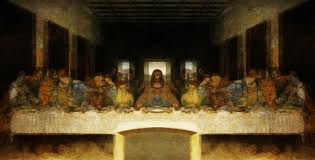The Last Supper
Leonardo Da Vinci, born in April 15, 1452 is considered one of the greatest painters in the world. He was an Italian renaissance Polymath: painter, sculptor, inventor, musician, anatomist and so much more. As a person, he was mysterious and remote and a man of unquenchable curiosity. Evidences of various inventions like a model of the plane he was working on way before the Wright Brothers came into the picture are a proof of his vivid and inventive imagination.
He has given the world some of the greatest paintings ever, including ‘Virgin on the rocks’, ‘The Vitruvian Man’, ‘The Last Supper’ and the most famous ‘Mona Lisa’. Various theories have always been developed for his paintings and speculations have been made about hidden messages in his paintings. ‘The Last Supper’ and ‘Mona Lisa’ have been the food for thought for a lot of curious minds and I too took the privilege of digging up some information and did my own little research. Since Mona Lisa and the speculations about the paintings have been done to death, I chose ‘The Last Supper’ because even though it is an event that has been chronicled in all four gospels, Leonardo’s version of the painting has brought with it a lot of ambiguity to this important religious event.
‘The Last Supper’:
The painting depicts the final meal that Christ shared with his Apostles before his crucifixion. Specifically the painting depicts the next few seconds in the story when Jesus drops the bombshell that one disciple would betray him before sunrise and the reactions of the 12 with different degrees of horror and anger.
The reason that Leonardo’s ‘The Last Supper’ gained so much prominence was because it was the first time that someone had painted the characters having a lively interaction. Other than that, the sheer size of the painting, which is 29 feet wide and 15 feet tall and the fact that it took 3 years to complete are a few reasons; why the painting has such an alluring quality. This wall painting is located on the end wall of the dining hall at the monastery of Santa Maria Delle Grazie in Milan, Italy.
Same Model for Judas and Jesus
Leonardo was known for his attention to detail when it came to human anatomy. Some researchers noticed a few similarities between Judas’ and Jesus’ faces in the painting and claimed that the model Leonardo had used to paint Jesus was the same model he had used to paint the character of Judas, this was however proven false. In the painting, Judas somewhat appears to lurk in the shadows, without a definite expression of anger or horror on his face.
The mystery of Jesus’ feet
Over the years the painting started deteriorating because Leonardo had used dry plaster for a more varied palette. Though he achieved what he intended to, he did not account for the durability and the painting began to flake off in the 1500s. Records show that because the painting had deteriorated to such an extent,the monks felt it was not worth saving anymore and built a doorway in the centre of the painting, destroying a part of the table and Jesus’ feet in the process.
Other reasons for the popularity of this painting are that historians over the years have made their own interpretations regarding the supposed hidden messages in the painting that Leonardo wanted people to decode. Their assumptions have been based on a variety of things ranging from the positions of the character, the way things were kept on the table to Jesus’ hand pointing towards the bread and the chalice.
Identity of the person towards Jesus’ Right
One of the most popular speculations made is on the ‘true’ identity of the person sitting towards Jesus’ right(viewer’s left). While initially it was believed to be John, others claimed that the figure is a woman and believed it to be Mary Magdalene. This theory was developed by Dan Brown in his book The Da Vinci Code. This raised many questions regarding the relationship that Jesus and Mary Magdalene shared. Though many have refuted these claims saying that John was the youngest of Christ’s disciples and the feminine touch added to figure by Leonardo was a way to show who John was in the painting.
Brown made his claims because of the strange V shape(feminine) between Jesus and John(who looks like a woman). Others said that the V shape signifies a strong relationship between the two and some also called this relationship homosexual. Brown’s claims were disregarded by the Roman Catholic Church. According to them his proclaims were “shameful and unfounded lies” it was disturbing for them that a piece of fiction could make people question the church. Their justification was that the book was a piece of fiction and these speculations were make believe.
Whether these speculations are true or false, we don’t know. While some may be based on valid evidences, they are still considered assumptions. Believing them is not mandatory and disregarding them is still an option.





